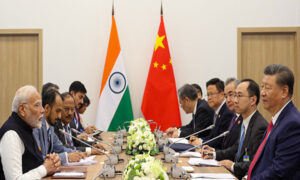
File Picture
The report of 27 American companies presently operating in China to shift their plants to Indonesia has created high hopes in India that many more such American manufacturing units might be interested in shifting to India in the wake of coronavirus Pandemic and deteriorating US China relationships in the last few weeks since President Trump accused China of being responsible for the spread of the coronavirus in the first place.
This was preceded by tensions over trade as the US accused that the Chinese were not importing enough from the US. According to the reports in a section of the Indian Media today the Government have already earmarked 4,16,590 acres of land in Maharashtra, Gujarat, Tamil Nadu and Andhra Pradesh and UP for such units. US India strategic Partnership Forum President mentioned that since 2019 elections, about 200 China based US manufacturing companies have been keen to shift their operations to India.
Is this ” shift” likely to take place soon ? is the question before any observer of the US China relationships from an Indian perspective. Let us look at facts objectively: Financial Times, London in its 10th May 20 issue reported that ” tens of thousands of US companies set up business in China and bilateral trade amounted to $ 541 billions while Chinese investment in US fell to $ 5 billions down from 2016 peak of $45 billions.”And 370000 Chinese students are presently studying in China with the clear object of internalising the US knowledge system. The Financial Times quoted President Trump in its last 14th May issue saying that ” we could cut off the whole relationship” and ordered the US Government’s main Pension Fund– US Federal Retirement Thrift Investment Board not to invest in Index Funds that buy Chinese stocks”.
From an Indian perspective it would be useful to have information about the Total number of US companies operating in China including the joint ventures of investers of both the countries, the amount invested in the same and the cumulative investment of US Pension Funds in China as these would give a definite by idea of how the US and the Chinese economies have been ” intertwined” since China embraced market led growth path- capitalism and especially after she joined the WTO in 2001. The Financial Times also informed that ” foreign investors poured in $ 10.7 billions into China’s $ 13 Trillion Bond market.”China is also the second biggest holder of the US Treasury Bills worth well over a Trillion US$.
In this scenario two developments in the last week or so are significant. First, the US action against Huawei ,the Chinese technology company that would restrict the ability of Huawei to develop semi conductors abroad with US technology and its efforts to undermine US export controls . Second on May 11 nine US Senators led by Thom Tillis introduced Covid 19 Accountability Act in the Congress seeking to authorize the President “to issue through sanctions if China fails to provide a comprehensive account of events leading to Covid 19″. Senator Tillis also unveiled the 18 point plan to investigate the US reliance on China’s supply chain and threats to public safety and national security. This is interesting as it gives a tacit recognition of the fact and high level of integration of the the US and Chinese economies and the difficulty of extricating the US economy from the same. Further, the fact that Republican Attorney Generals of 14 American states have asked the President to form a State Federal Partnership to make China pay for damages for the Covid 19 only shows how desperately the ruling elite of the US feel insecure in the face of the growing Chinese role in the world affairs when prudence suggests only recalibration of US engagements with China.
We can not also ignore the fact that while the US is blaming China for spread of COVID-19 the Daily Mail expose in early May this year and quoted in the Indian Media revealed that the US National Institute of Health, a US Govt Agency had given a $3.7 million Research grant to the Wuhan Institute of Virology, China.So there is more to it than what meets the eye. And this takes us to the larger issue that Paul Kennedy articulated in his” Preparing for the Twenty First Century”that is,the relevance of the idea of a national economy in the era of globalization because the” products” are no longer made in one country nor capital and technology for the same sourced from one country. He thus argued that the” very idea of American economy is becoming meaningless” which holds good for other advanced countries as well.
This being the ground reality one must note that Trump’s belligerence may have much to do with his electoral strategy for the ensuing Presidential election in November this year as he is facing severe criticism of his handling of COVID- 19 Pandemic that has caused over 88000 deaths in the US by now and his China policy. While Trump’s ratings are falling his options are narrowing because even he issues a diktat, the US companies in China are unlikely to rush to move out of China to other places for the freedom such corporates enjoy under the US laws to conduct their business in the interest of the shareholders. Trump’s threat to slap new taxes on US companies like Apple to dissuade them from moving their present manufacturing base in China to India or Ireland instead of US must be read as a part of his program to have the supply chain in US which appeals to his electorate. And yet observers feel that there are strong reasons for continuing in China as China offers integrated infrastructure like Ports, High ways, high quality logistics especially developed land, top quality skilled manpower deemed essential to enable the companies to meet deadlines the international companies operate on . The next stop from China they feel is still China. While this may appear too conservative the fact remains that to be a part of the existing global supply chain capable of meeting the demanding standards of global trade the new units would require, what is called an ” ecosystem” similar to one that it enjoyed in China which is found in good shape in ASEAN countries. Further ,membership of RCEP- Regional Comprehensive Economic Partnership helps the exporters of RCEP countries to benefit from tariff free access to destination markets on reciprocal basis- a big advantage that India based companies would not get as India has not joined the group.
It is quite possible that Trump would realise soon that retaliatory action is not a valid strategic option in such a complex situation and like Japan will unveil a funding package to shift key supply chain from China. Germany has already opted for production of essential health care products in Germany and within the European Union countries.
On the whole the global trade and development scenario is fluid and to take advantage of the situation India must put in place a coherent synergy to revamp the activities of its net work of the Special Economic Zones – 203 under the states and 7 under the Centre, ensure implementation of the National Science Technology and innovation Policy 2013 to enable industries to move to ” high value” manufacturing as China completed this transition in 2017, South Korea and Singapore ,carry out reforms to facilitate Foreign Direct investment and labor laws in tune with the standards the MNCs are required to follow and other areas so as to create the necessary ” ecosystems” the US and EU companies get in China.
The competition to attract such companies among the ASEAN and other countries would be fierce as South Korea and Taiwan are being seen as appropriate destinations for the Hi tech and Vietnam and Bangladesh for low end. India can meet the requirements of both and need FDI to reorder the economy now in the midst of coronavirus Pandemic. It’s time now to give a hard look at the economy to put in place a ” coherent synergy” approach to turn hope into reality.
[the_ad id=’22723′]


















